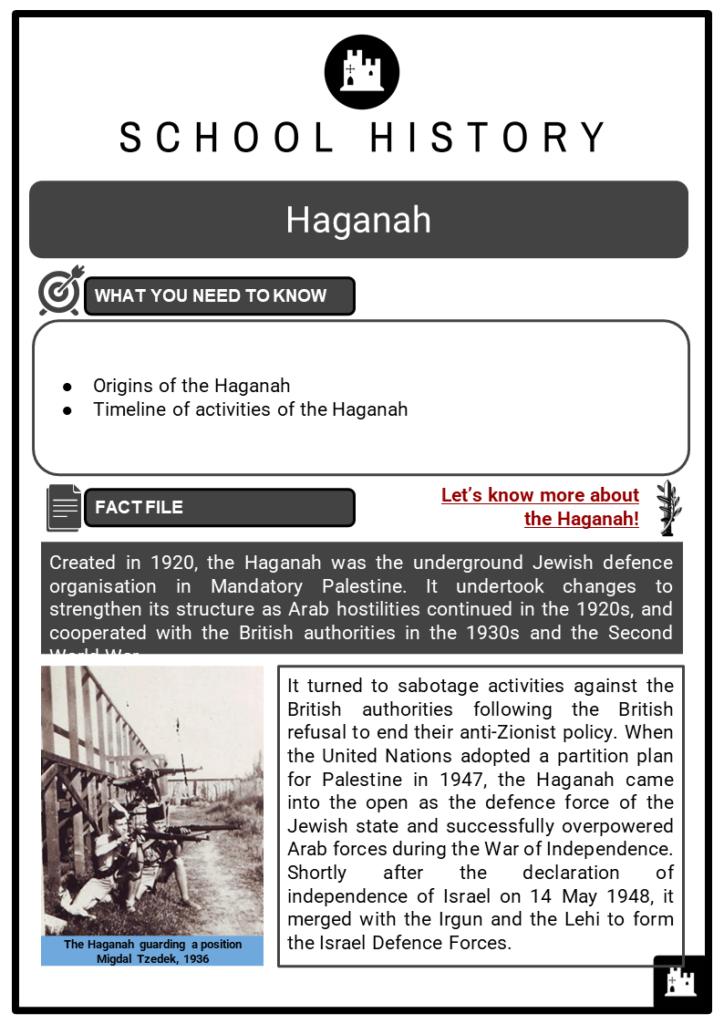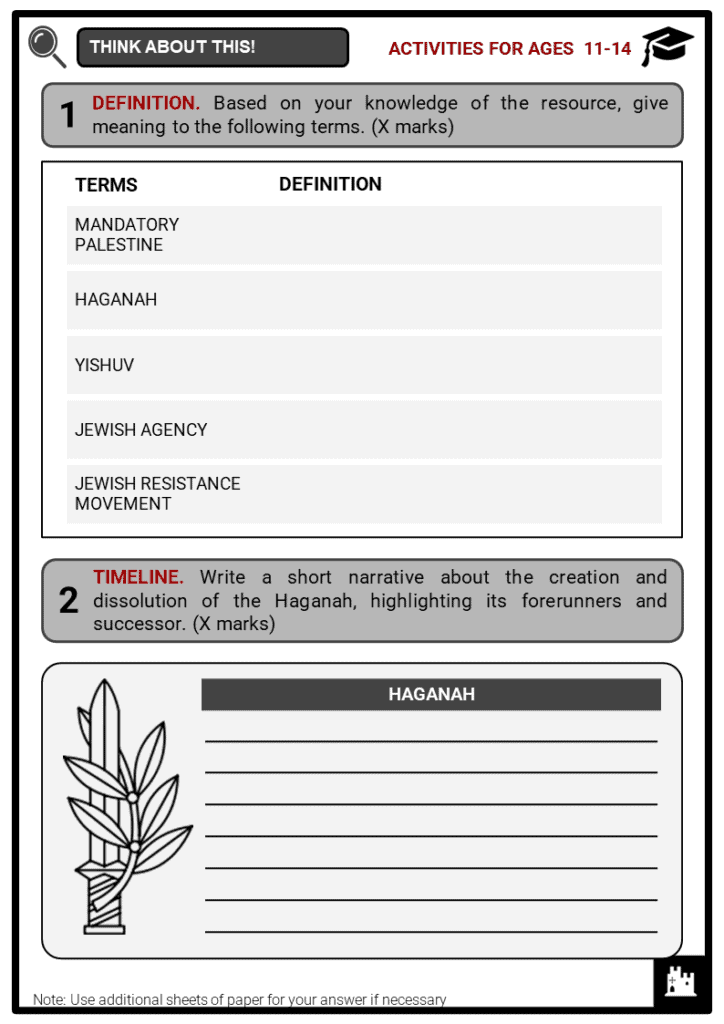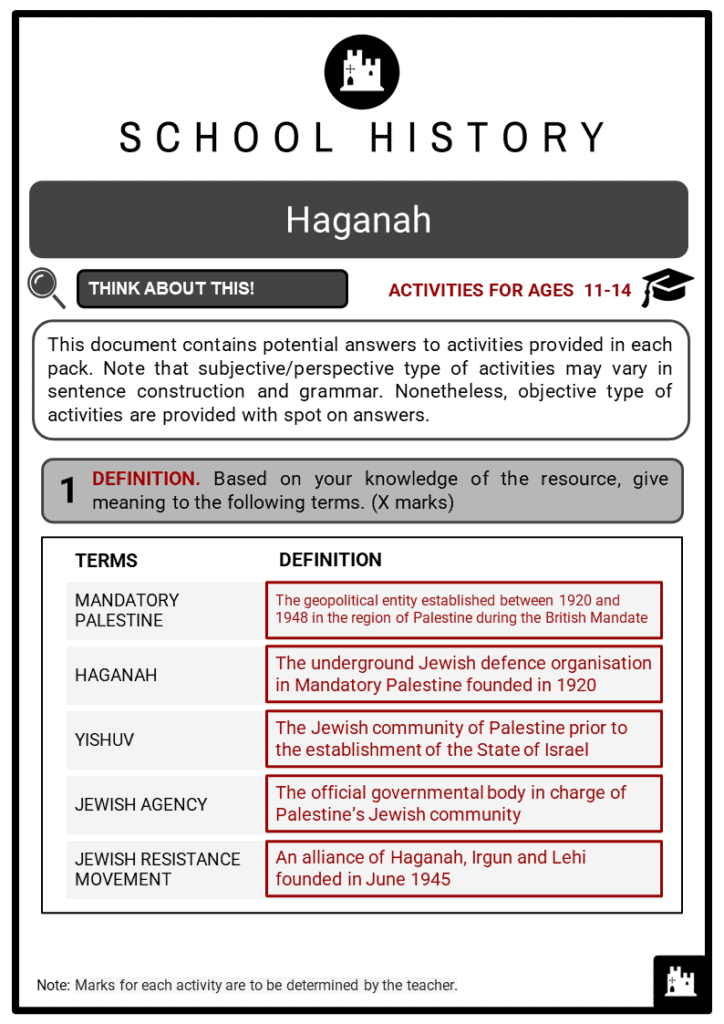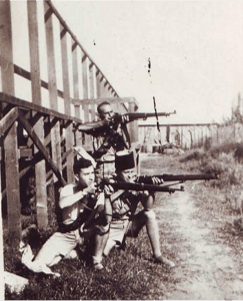Download Haganah Worksheets
Do you want to save dozens of hours in time? Get your evenings and weekends back? Be able to teach Haganah to your students?
Our worksheet bundle includes a fact file and printable worksheets and student activities. Perfect for both the classroom and homeschooling!
Table of Contents
Add a header to begin generating the table of contents
Summary
- Origins of the Haganah
- Timeline of activities of the Haganah
Key Facts And Information
Let’s know more about the Haganah!
- Created in 1920, the Haganah was the underground Jewish defence organisation in Mandatory Palestine. It undertook changes to strengthen its structure as Arab hostilities continued in the 1920s, and cooperated with the British authorities in the 1930s and the Second World War.
- It turned to sabotage activities against the British authorities following the British refusal to end their anti-Zionist policy. When the United Nations adopted a partition plan for Palestine in 1947, the Haganah came into the open as the defence force of the Jewish state and successfully overpowered Arab forces during the War of Independence. Shortly after the declaration of independence of Israel on 14 May 1948, it merged with the Irgun and the Lehi to form the Israel Defence Forces.
Origins of the Haganah
- Small Jewish self-defence groups in Palestine were active during Ottoman rule. After the First World War, the Ottoman territories were divided and the British Mandate for Palestine was created.
- During the British rule in Mandatory Palestine, it appeared that a Jewish defence organisation would not be needed given that a European power had assumed responsibility for maintaining civil order with the assistance of legally constituted forces from the Yishuv.
- Yishuv was the Jewish community of Palestine prior to the establishment of the State of Israel in 1948.
- However, the promise of peace and security was shattered with the occurrence of Arab assaults and threats on Jewish settlements in 1920.
- This led to the realisation that the Yishuv must create an independent defence force, completely free of foreign authority for both security and political considerations.
- In June 1920, the Haganah was created. It was under the supervision of the Jewish Agency, the official governmental body in charge of Palestine’s Jewish community.
- The Hashomer and the Jewish Legion were the forerunners of the Haganah.
- Founded in 1909, the Hashomer consisted of a group of emigrants who offered protection to the Jewish settlements in return for an annual fee. Originally known as Bar Giora, it was formally disbanded after the establishment of the Haganah in 1920.
- Formed in 1914, the Jewish Legion was the name given to the five battalions of Jewish volunteers raised by the British army to fight against the Ottoman Empire during the First World War. After the war, several hundred volunteers fought against demobilisation believing that the establishment of Israel required protection. A mere 300 to 400 men remained by the spring of 1920.
- What was the purpose of the Haganah?
- To guard the Jewish communities and farms from possible attacks by Arab gangs
- To warn the residents and repel the attacks
Timeline of activities of the Haganah
- During the early years of its existence, the Haganah was a loose organisation of local defence groups in the large towns and in several of the settlements. Its structure dramatically changed in the succeeding years. In agreement with its official policy of havlagah or ‘self-restraint’ and in opposition to the political philosophy and terrorist activities, the activities of the Haganah were generally moderate.
- 1920s - During the Arab riots, the Haganah was able to protect the establishment of more than fifty new settlements in Palestine. Its units were localised on the extreme part of the territory and had very limited weapons.
- 1929 - The Arab uprisings led to the death of hundreds of Jews and Arabs. The city of Hebron was faced with a sort of ethnic cleansing since 70 Jews were killed and 500 others were forced to flee. This forced the Haganah to reorganise abruptly:
- It became a large organisation that comprised nearly all the youth and adults in the settlements, as well as several thousand members from each of the cities.
- It initiated a comprehensive training programme for its members, eventually turning its untrained militia into an efficient army.
- It established central arms depots into which a continuous stream of light arms flowed from foreign nations.
- 1931 - Members of the Haganah who opposed the havlagah, splintered off and formed the Irgun Zvai Leumi.
- 1936- 1939 - The Haganah actively protected British interests and countered Arab insurgents. Although the British administration did not officially acknowledge the Haganah, the British security forces cooperated with it by creating the Jewish Settlement Police, the Jewish Supernumerary Police and Special Night Squads.
- 1939 - The British government issued the White Paper of 1939. As a result, the Haganah supported illegal immigration, organised demonstrations against the British Anti-Zionist policy expressed in the paper, and began building up its elite fighting force known as the Palmach.
- The White Paper of 1939 essentially submitted to Arab demands. It declared that the Jewish national home should be established within an independent Palestinian state. Moreover, it limited Jewish immigration to 75,000 for five years and ruled that further immigration would then be determined by the Arab majority.
- 1939- 1945 - With the outbreak of the Second World War, the British authorities asked for the cooperation of the Haganah. All in all, some 30,000 Palestinian Jews served in the British army during the war.
- The Haganah headed a movement of volunteers when the British army announced the formation of the Jewish Brigade Group.
- It cooperated with British intelligence units and sent its personnel out on various commando missions in the Middle East.
- The Palmach was formally established in 1941 and its members, young men and women, received specialist training in guerrilla tactics and sabotage.
- The Haganah further fortified its independence during the war.
- 1945 - At the end of the war, it became clear that the British government had no intention of changing its Anti-Zionist policy. The Jewish Resistance Movement, an alliance of Haganah, Irgun and Lehi, was founded in June.
- The combined forces began an open, organised struggle against the British rule. Although the Haganah was less active than the other two groups in the Jewish rebellions, the Palmach carried out anti-British operations including a raid on the Atlit detainee camp, and sabotages and raids against radar installations and the British police.
- 1946 - Following Operation Agatha and the King David Hotel bombing, the Haganah left the Jewish Resistance Movement. However, it refused to cooperate with the British authorities and continued to support illegal immigration.
- 1947 - The British referred the issue of Palestine to the United Nations (UN), which then formed an inquiry committee made up of members from eleven countries to investigate a suitable course of action.
- Initial proposals for the division of Palestine:
- Proposal A: Two separate states joined economically
- Proposal B: A single bi-national state composed of autonomous Jewish and Arab regions
- The Palestine Partition Plan based on the committee’s modified report was submitted to the UN General Assembly. Whilst the fate of the resolution was initially uncertain, it was ultimately passed with 33 votes in favour, 13 against and 10 abstentions.
- David Ben-Gurion, president of the Jewish Agency and political leader of the Haganah, ordered the reorganisation of Haganah and the preparation for the impending Arab attack by building up its arms and munitions stocks.
- Emerging as the defence force of the Jewish state, the Haganah clashed openly with British forces and successfully overpowered the military forces of the Palestinian Arabs and their allies during the War of Independence. The Arab populations in the Jewish areas began to leave.
- 1948 - On 14 May, Israel was officially declared an independent state, with Ben-Gurion as the first prime minister. By this time, the Haganah controlled not only most of the settled areas allocated to Israel by the partition but also Arab cities such as Acre and Jaffa. Less than two weeks after the creation of Israel, the provisional government founded the Israel Defence Forces or the Tzva Haganah le-Yisraʾel, merging the Haganah, Irgun and Lehi.
- The Haganah was dissolved as a private organisation while the other two groups continued to operate independently in Jerusalem and abroad for some time after.
Image sources:









